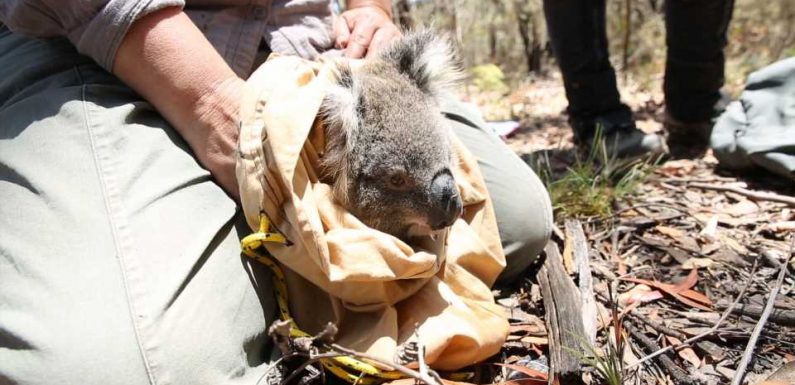
© Courtesy of SDZWA
San Diego Zoo Goes Global to Save Threatened Wildlife
Courtesy of SDZWA Hundreds of koalas were given shelter during Australia’s wildfires.
Load Error
The key in Wednesday’s news is the “alliance” part: The famous zoo, the most visited in the United States, wants to build on its 105-year history of collaboration with international organizations, which spans 52 countries and almost 350 partners, and translate the insight gained at the San Diego sites into conservation work that has an impact globally. The zoo has helped mitigate dozens of wildlife disasters in recent years, from koala habitats destroyed in the Australia wildfires to white rhinos facing extinction, and it hopes to be even more successful with this collaborative approach.
It also wants to engage the 5 million+ visitors who tour the zoo and the safari park in San Diego’s Balboa Park in a normal year, raising awareness of the issues the planet’s animals face, encouraging them to become “Allies for Wildlife” and make donations at SDZWA.org.
The news comes at an urgent time. Wildlife is in “catastrophic decline,” WWF says, with wildlife populations falling by more than two thirds in less than 50 years. (The study looked at thousands of species globally and recorded a 68 percent drop in 20,000 populations of mammals, amphibians, birds, and reptiles, the BBC reports.) Climate change, diversity loss, and wildlife trafficking remain ever-present threats.
“While the San Diego Zoo is synonymous with some of the greatest advancements in wildlife care and conservation, our future depends on a sustained and committed focus to the health and well-being of all life on earth,” Paul Baribault, president and CEO of San Diego Zoo Wildlife Alliance, said in a release. “We must evolve to meet the growing needs of wildlife in the 21st century and we can’t do this alone. We are placing partnerships and hope at the heart of our organization through this transformation.”
Baribault elaborated on future projects over email to AFAR. “We are committed to focusing our efforts around eight different conservation hubs around the globe—[U.S.] Southwest, Savanna, Amazonia, Oceans, Pacific Islands, Asian Rainforests, African Forests, Australian Forests,” he said, adding that the organization’s fieldwork focus will be a “one health approach.”
“We all realized after 2020 that the health of wildlife is tied directly to the health of people and the health of ecosystems. We have to think of the solutions holistically.”
The organization has also collaborated with artist Romero Britto for a color-splashed new mural at the zoo.
A long history of conservation
SDZWA has been helping animals from across the zoological spectrum for some time. The zoo’s Institute for Conservation Research focuses on the conservation of animals, plants, and habitats and works on the frontlines against extinction in key areas, including genetics, recovery ecology, and community engagement (its manifesto explains more).
In the battle to sustain giant panda populations, it worked with partners in the U.S. and China, studying the animals’ mating and denning habits in the wild and the effects of human disturbance. Collaborative research on reproductive cycles enabled the birth and survival of six cubs at the San Diego Zoo as well as an increase in panda numbers at China’s Wolong Breeding Center, from 25 to 130 in a decade. Talk now is of reintroducing pandas into the wild.
When huge fires ravaged Australia in late 2019, the zoo raised more than $1 million from visitors for wildlife-saving efforts. On the ground, San Diego Zoo Global worked with Science for Wildlife to house koalas in a refuge at Taronga Zoo before reintroducing them to the wild when the time was right. Researchers say that the burned Blue Mountains World Heritage region is home to “the most genetically diverse population of koalas in the world.”
In Kenya, SDZWA works with the Northern Rangelands Trust and Save the Elephants at the community-owned Reteti Elephant Sanctuary, where 10 orphaned elephant calves have been released. Wildlife care specialists at the Safari Park in San Diego have analyzed milk samples from elephant mothers, which helped to develop high-quality milk substitutes for the calves.
The zoo’s Wildlife Biodiversity Bank, meanwhile, dates back to 1975 and houses more than 10,000 individual cell lines from 1,100+ species and subspecies, including over 300 vulnerable or critically endangered species. One of the most promising projects? Averting white rhino extinction. There are only two northern white rhinos left on Earth, but the team hopes to save the species by analyzing genome sequences and use reproductive technology, resulting in the potential birth of new rhinos at the Nikita Khan Rhino Rescue Center at the safari park.
The conservation challenges of 2021 and beyond are not insignificant, but SDZWA CEO Paul Baribault remains optimistic. The next 10 years are “focused on a vision to build a world where all life thrives,” he says, where “we can bring all of our unique conservation skills that we develop here at the San Diego Zoo Safari Park to those partners in the field to truly drive greater outcomes for wildlife.”
Both the San Diego Zoo and San Diego Zoo Safari Park are open to the public, but anyone ages three and up will need a ticket or membership and a reservation to visit. Visitor capacity is lower right now to account for social distancing, and masks are required. Full COVID-related advice is available on the site.
>> Next: Kenya’s Imperiled Wildlife Conservancies Receive Financial Lifeline
Source: Read Full Article










